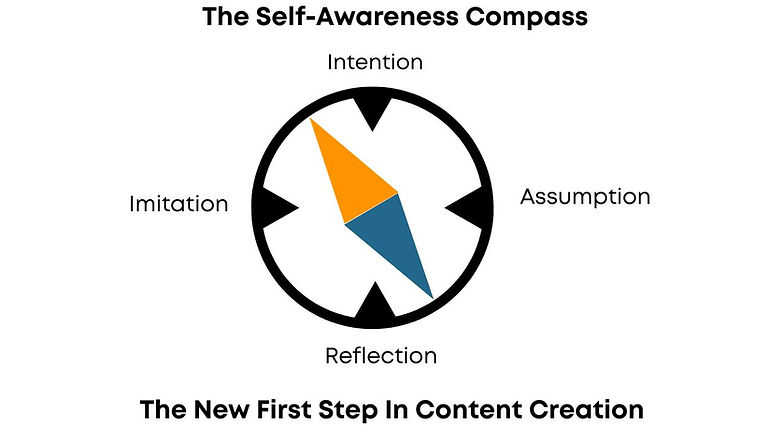
The S.T.A.M.P.
Framework
The Guide to Help You Apply it to Your Content

Self-Awareness
It's at the heart of what should be the first step in modern content creation or improvement.
It’s about being intentional with your words, your purpose, your audience assumptions—and the habits that might be doing more harm than good.
Evaluate Your Self-Awareness in Content
Stop and ask yourself questions about the motivations, processes and thinking behind the content.
1. Are we creating this content for us or for our audience?
2. Are we stuck in habits we haven’t questioned?
3. Are we copying what others are doing because it feels safe?
4. What assumptions or language about audience might disrupt content connection?

Think of this step like a content compass.
A compass can help us point in the right direction before we move forward. This one helps you pause before publishing so you can create content with purpose, clarity, and alignment with what truly matters to your audience and your business.
N
intention
Catch yourself when the motivation is urgency, pressure, or default thinking. Realign with a purposeful intent that considers your audience first.
s
reflection
Auto-pilot is where human content dies. Consider use of worn-out formats, old marketing habits, or strategies that don't align with content or audience trends.
e
assumption
Assumptions about your audience often slip into your language without notice. What do we actually know about our audience's attitudes and experience with content?
w
imitation
Businesses copy what they see others do when it comes to content. Break the cycle, take a stand, be creative, and give your audience something surprisingly different.
Self-Awareness Checklist
-
We’ve paused to reflect on why we’re creating this and who it’s really for
-
We’ve eliminated language that assumes too much (or too little) about our audience
-
We’ve questioned familiar habits and chosen a tone that feels fresh, not formulaic
-
We've questioned our assumptions about what our audience needs/wants
-
We've considered our own consumer attitudes about content
More on Self-Awareness

Two-Way Communication
According to communication theory, the only goal for one-way communication is for it to get to someone.
Content today has to be rooted in two-way communication as a means of always thinking about the audience connections, reactions and responses.
Create Content That Welcomes Perspective, Not Push One
When content feels like human communication, it builds trust, empathy, and connection.
1. Are we trying to convince… or connect?
2. Are we leaving space for the audience to see themselves in the content—or only showing what we want them to see?
3. Are we inviting input, dialogue, or feedback in meaningful ways?
4. Are we assuming the audience agrees or understands—without making space to clarify, explore, or engage?
Two-Way Communication in Content
Two-Way Comms Checklist
-
Content invites meaningful response (not just "like and subscribe")
-
We've included authentic questions or conversation starters
-
We've allocated resources to respond to comments/engagement
-
Our tone is conversational rather than presentational
-
We've addressed common questions or feedback from previous content
-
We've designed content that builds on previous audience interactions
More on Two-Way Communication

Adaptability
Adaptability isn’t just about change; it’s about a company culture that empowers it. In content strategy, that means evolving based on shifting audience behavior, and marketing trends.
Break Habits That Keep Your Content (and People) Stuck
Challenge what’s outdated to make space for better ideas, braver voices, and content that connects.
1. Are we relying on content formats, structures, or strategies simply because they’ve always been used?
2. Do we treat successful past content as a proven template—or a reason to re-explore what made it successful?
3. Are we open to trying new approaches, platforms, or voices—or do internal comfort zones limit our progress?
4. Do our content habits reflect the change around us?
Creating an Adaptive Process

Spot the Signals
Pay attention to audience and content strategy shifts. Not all trends are threats - wake-up calls for meaningful change. Make it a point to view adaptability as a means to stay ahead of the competition and relevant to your audience.

Question the Familiar
Comfortable formats, messages, and “best practices” can become outdated fast. Reexamine what you repeat. Is it still relevant—or just familiar? Ask whether it still reflects who you are, what your audience values, and how people communicate today.

Experiment with Intention
Don’t chase hype. Instead, pursue meaningful change. Give creative thinkers room to test new ideas in controlled ways, not as a risk, but as a response to shifting audience behaviors and needs. Learn from what resonates and use it to evolve with purpose.
Adaptability Checklist
-
We regularly review content performance metrics and adjust accordingly
-
We have a process for testing new content formats or approaches
-
Our content calendar allows flexibility for timely, relevant content
-
We allocate time and resources for learning about new trends
-
Our team is empowered to suggest improvements to our approach
-
We have a feedback loop to incorporate audience insights
More on Adaptability

Meaningful Language
Your audience knows when content sounds like marketing copy, and they're tired of language that feels fake and self-serving. Think about the VOICE of your content and how your audience may react to it.
Reframe The Way Content Communicates
Break away from the generic, copy-and-paste marketing language that fills the internet and sounds just like everyone else by writing content that sounds like a real person talking to someone they care about.
1. If I said this out loud to someone at a conference, would it sound weird or robotic?
2. Does our content communication align with our audience's language?
3. Does our language stand out from commonly-used content from brands?
4. What is the "voice" of the copy - a commercial, a helpful voice, or something else?
5. Do we sound scripted or conversational?
Meaningful Language Checklist
-
We identified any language or approaches that doesn't differentiate us
-
We identified words that could generate red flags to our audience
-
We compared our own experiences with problematic content language
-
We reframed copy to sound more human-to-human
-
We're testing new approaches to see what resonates
-
We're monitoring audience responses and reactions
More on Meaningful Language

Predictive Intelligence
Your audience brings past experiences, emotions, and defenses to every piece of content they encounter. Understanding their behaviors, concerns, and likely reactions helps you create content that connects instead of gets ignored or rejected.
Understand How Humans React to Content
You don’t have to guess how people behave. Decades of research and your own patterns offer clues. Use them to shape content that feels real and resonates.
1. What content frustrations have people faced, and are we repeating them?
2. What patterns are we noticing in what people ignore, reject, or avoid?
3. What insights haven’t made it into the way we communicate yet?
4. Do we know what actually builds or erodes trust over time—and are we tracking it?
5. Beyond buying, what other valuable behaviors might our audience take (referrals, sharing, advocacy), and how can we create content that encourages those actions?
Learn to Lower Audience Defenses

Research Their Real Experiences
-
Talk to sales, customer service, etc. about what people say
-
Conduct interviews with customers and non-buyers
-
Join communities where your audience discusses real problems
-
Study their emotional state—stressed, skeptical, or overwhelmed
.jpg)
Predict Their Reactions (and Yours)
-
Anticipate scrolling past or closing content quickly
-
Expect avoidance to prove your tactics don't work
-
Consider behaviors beyond buying - like sharing, referring, staying engaged
-
Factor in their past negative experiences with marketing

Test and Create Content That Disarms
-
Acknowledge their skepticism upfront
-
Use social analytics and listening to test assumptions
-
Address concerns before they become barriers
-
Provide genuine value first
-
Understand their time constraints and get to the point quickly
Predictive Intelligence Checklist
-
We’ve considered what our audience is used to experiencing and how they react
-
We’ve factored in negative past experiences that might shape how they view content like ours
-
We’ve looked for patterns that reveal unmet needs or shifting expectations
-
We’ve talked with other departments that engage with customers and prospects to gain insight
-
We’ve paid attention to audience behavior (scrolling, skipping, pausing) to inform content direction
-
We’ve updated our assumptions based on how people actually engage













.jpg)
.jpg)
.png)



